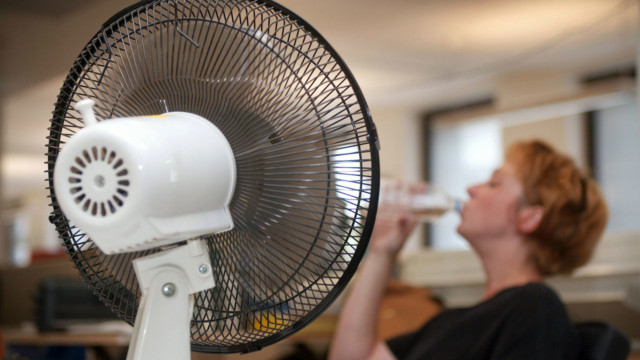THE sun is out and temperatures are climbing, but it looks like most of us are sweltering in an office with little air conditioning, instead of relaxing outdoors or paddling in a cool tub.
This week could see temperatures hit up to 43C as Brits prepare for the hottest day of the year.
As temperatures hit glorious levels, make sure you’re bringing water to work and wearing baggy clothing where possible
If you do have to head to work when you would rather be taking a trip to the beach, we explain what rights you have when it’s too hot in the office.
What rights do I have if it’s too hot in the office?
Unfortunately, there’s no legally defined minimum or maximum temperature for offices or other places of work.
Employers have to make sure conditions are “reasonable” – but what counts as reasonable is open to interpretation.
The Health and Safety Executive has suggested before that workplaces should have a minimum temperature of 16C.
For work that is very physical, for instance factory floors, it suggests a lower minimum of 13C.
Unfortunately, it has said that it cannot give a meaningful maximum temperature, because some kinds of businesses will be hot by definition – such as glassworks or bakeries.
Bosses should ensure their workers have access to water and monitor their wellbeing in hot weather, according to HSE guidelines.
Typical symptoms of heat stress are:
- an inability to concentrate
- muscle cramps
- heat rash
- severe thirst – a late symptom of heat stress
- fainting
- heat exhaustion – fatigue, giddiness, nausea, headache, moist skin
- heat stroke – hot dry skin, confusion, convulsions and eventual loss of consciousness. This is the most severe disorder and can result in death if not detected at an early stage
If you’re a vulnerable employee – for example pregnant or menopausal – you should take this into account when deciding on a plan of action.
The HSE has said: “If a significant number of employees are complaining about thermal discomfort, your employer should carry out a risk assessment, and act on the results of that assessment.”
That means that if you’re uncomfortable, you should tell your boss or HR and if enough people complain the business needs to investigate.
You may not get to work from home though, instead the business might provide fans, relax dress codes, turn up air con, or look at other measures to make things more comfortable.
The TUC has said previously it wants to make it illegal to keep people at work indoors if the temperature is above 30C.
People working from home may also be struggling. Here’s our top tips for beating the heat.
What are the temperature recommendations?
The Chartered Institute of Building Services Engineers recommends the following temperatures for different working areas:
• Heavy work in factories: 13°C
• Light work in factories: 16°C
• Hospital wards and shops: 18°C
• Offices and dining rooms: 20°C
What are my rights if I need to take public transport?
Each transport company sets its own policies – and there’s no law about temperatures during a heatwave.
This can mean that travellers face extremely high temperatures.
For example, in 2018, Londoners complained of 42C temperatures on the Tube – higher than the legal limit for transporting cattle.
Transport for London has said that all Tubes will be air-conditioned by 2030.
It’s no longer the law to wear face coverings on public transport, but you’re asked to wear one on the tube or in crowded places, be careful not to overheat if it’s causing you discomfort.
Make sure you bring a bottle of water with you and if possible wear cool, loose clothing.
People are sharing their best “air con” hacks to keep cool in the heatwave and all you need is a bottle of water.
If you’re sat at work wincing in pain at sunburn caught over the weekend, here’s five ways to soothe it.








